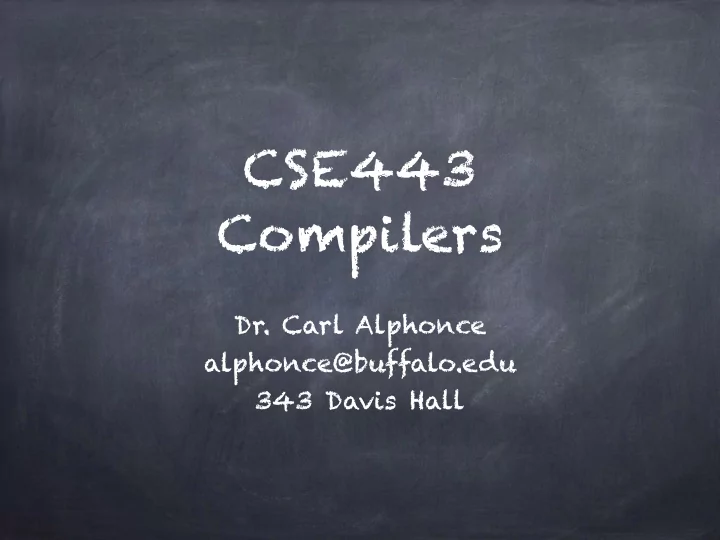

CSE443 Compilers Dr. Carl Alphonce alphonce@buffalo.edu 343 Davis Hall
Team formation Please sit with your teams starting next week. C vs SML?
Lexical Phases of structure a compiler Figure 1.6, page 5 of text
languages & grammars Formally, a grammar is defined by 4 items: 1. N, a set of non-terminals 2. ∑ , a set of terminals 3. P, a set of productions 4. S, a start symbol G = (N, ∑ , P, S)
languages & grammars N, a set of non-terminals ∑ , a set of terminals (alphabet) N ∩ ∑ = {} P, a set of productions of the form (right linear) X -> a X -> aY X -> ℇ X ∈ N, Y ∈ N, a ∈ ∑ , ℇ denotes the empty string S, a start symbol S ∈ N
Lexical Analysis Lexical structure described by regular grammar Deterministic finite state machine performs analysis
LANGUAGE operations If L and M are regular, so are: L ∪ M = { s | s ∈ L or s ∈ M } union LM = { st | s ∈ L and t ∈ M } concatenation L * = ∪ i=0, ∞ L i Kleene closure By definition, L 0 = { ℇ }
Given an alphabet ∑ REGular EXpression (regex) Inductive definition ℇ is a regex 𝓜 ( ℇ ) = { ℇ } For each a ∈ ∑ , a is a regex 𝓜 (a) = {a}
Regular expressions (regex) Inductive definition Assume r and s are regexes. r|s is a regex denoting 𝓜 (r) ∪ 𝓜 (s) rs is a regex denoting 𝓜 (r) 𝓜 (s) r * is a regex denoting ( 𝓜 (r)) * (r) is a regex denoting 𝓜 (r) Precedence: Kleene closure > concatenation > union Associativity: all left-associative (minimize use of parentheses: (r|s)|t = r|s|t )
Algebraic laws Assume r and s are regexes. Commutativity r|s = s|r Associativity r|(s|t) = (r|s)|t and r(st) = (rs)t Disributivity r(s|t) = rs|rt and (s|t)r = sr|tr Identity ℇ r = r ℇ = r Idempotency r ** = r *
We can describe a regular language using a regular expression
A regular expression can be recognized using a finite state machine. Machines: NFA non-deterministic finite automaton DFA deterministic finite automaton
Process of building lexical analyzer 1) spell out the language language
Process of building lexical analyzer 2) formulate a regular expression language regex
Process of building lexical analyzer 3) build an NFA language regex NFA
Process of building lexical analyzer 4) transform NFA to DFA language regex NFA DFA
Process of building lexical analyzer 5) transform DFA to a minimal DFA language regex NFA DFA DFA
Process of building lexical analyzer 5) The minimal DFA is character our lexical analyzer stream language regex NFA DFA DFA token stream lexical analyzer
Focus for today regex NFA
Nondeterministic Finite Automata (NFA) A finite set of states S An alphabet ∑ , ℇ ∉ ∑ 𝛆 ⊆ S X ( ∑ ∪ { ℇ }) X 𝒬 (S) (transition function) s 0 ∈ S (a single start state) F ⊆ S (a set of final or accepting states)
Deterministic Finite Automata (DFA) A finite set of states S An alphabet ∑ , ℇ ∉ ∑ 𝛆 ⊆ S X ∑ X S (transition function) s 0 ∈ S (a single start state) F ⊆ S (a set of final or accepting states)
Initial state: arrow from Regex -> NFA nowhere pointing in. Often labelled state 0. ℇ 1 0 N(s) ℇ ℇ 0 1 Final state: drawn with a ℇ double circle ℇ N(t) a 1 0 Arrows are labeled with ℇ or a ∈ ∑ . S | t for each a ∈ ∑
Regex -> NFA ℇ 1 0 N(s) ℇ ℇ 0 1 ℇ ℇ N(t) a 1 0 S | t for each a ∈ ∑
Regex -> NFA St 0 1 N(s) N(t) ℇ ℇ S * 0 1 N(s) ℇ ℇ
Simple example static
Simple example static c s t a t i 0 1 2 3 4 5 6
Simple example static struct c s a t i t ℇ 0 1 2 3 4 5 6 ℇ i F t s t r u c ℇ ℇ 7 8 9 10 11 12 13
Recommend
More recommend